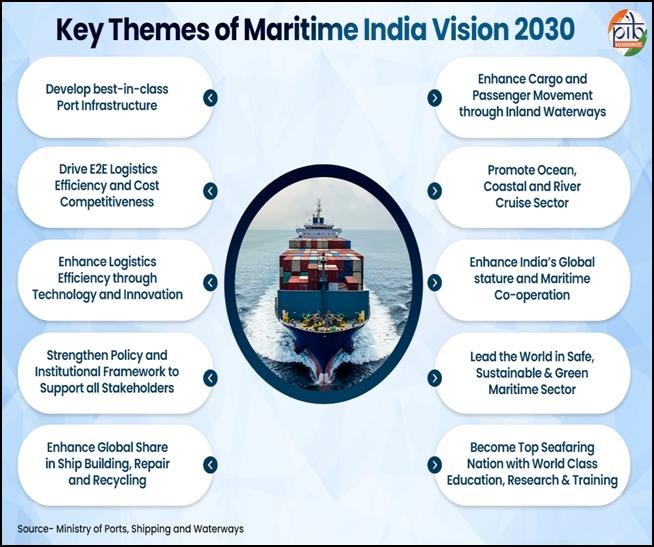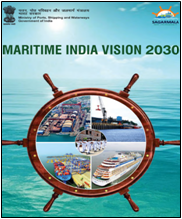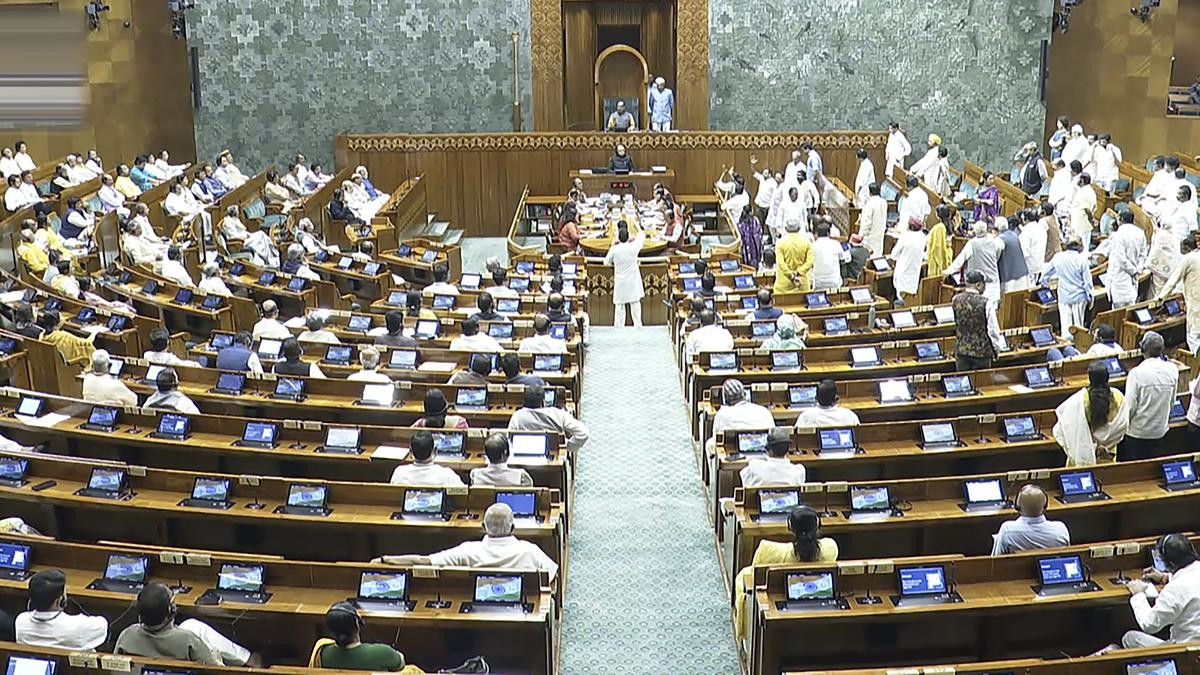Copyright infringement not intended
Picture Courtesy: PIB
Context:
Maritime India Vision 2030, launched in 2021, seeks to transform India into a global maritime powerhouse through modernized ports, expanded shipping capacity, inland waterways development, and skill-building, while emphasizing sustainability.
Current Status:
- Nearly 95% of India’s trade by volume and 70% by value moves via maritime routes, underscoring the sector’s economic significance. (Source: PIB)
- Maritime India Vision (MIV) 2030 outlines 150+ initiatives with projected investments of ₹3–3.5 lakh crore, supported by a ₹69,725 crore shipbuilding package. (Source: PIB)
- In FY 2024–25, major ports handled approximately 855 million tonnes of cargo, reflecting growth in trade and port efficiency. (Source: PIB)
Key Themes:

Picture Courtesy: PIB
Maritime Growth: 2014–2025:
Ports
- Port capacity nearly doubled from 1,400 MMTPA to 2,762 MMTPA
- Cargo volumes rose from 972 MMT to 1,594 MMT (Source: PIB)
- Average vessel turnaround time reduced from 93 hours to 48 hours
- Net annual surplus surged from ₹1,026 crore to ₹9,352 crore
Shipping
- Indian-flagged vessels increased from 1,205 to 1,549
- Fleet gross tonnage rose from 10 MGT to 13.52 MGT
- Coastal shipping doubled cargo movement from 87 MMT to 165 MMT (Source: PIB)
Inland Waterways
- Cargo movement jumped from 18 MMT to 146 MMT (710% increase)
- Operational waterways expanded from 3 to 29
- Ferry and Ro-Pax services carried 5 crore passengers in 2024–25
- Seafarer workforce grew from 25 lakh to over 3 lakh, representing 12% of the global workforce (Source: PIB)
Broader impacts of India’s Maritime Growth:
Economic Impacts
- Trade Growth: Efficient ports and shipping networks enhance India’s global trade connectivity, supporting exports of goods like coal, textiles, electronics, and agricultural products.
- Investment Opportunities: Mega projects and shipbuilding initiatives attract domestic and foreign investments, such as the ₹66,000 crore MoUs signed in 2025.
Industrial & Technological Impacts
- Shipbuilding Advancement: Investments in greenfield shipyards and technology centres (e.g., ISTC in Visakhapatnam) strengthen India’s domestic shipbuilding capacity.
- Digital & Smart Ports: Adoption of digital tools and automation improves port efficiency and reduces operational costs.
Social & Human Capital Impacts
- Skill Development: Training programs for seafarers, port operators, and logistics personnel enhance employability.
- Tourism Promotion: Cruise services, Water Metro projects, and maritime heritage sites boost local economies and create tourism-linked jobs.
Environmental & Sustainability Impacts
- Green Shipping Initiatives: Promotion of hydrogen bunkering, methanol-fuelled vessels, and green corridors reduces maritime carbon footprint.
- Sustainable Port Operations: Improved logistics, reduced turnaround times, and cleaner transport contribute to environmental efficiency.
Strategic & Global Impacts
- Maritime Leadership: India is positioning itself as a major maritime and shipbuilding hub, enhancing its global influence.
- Supply Chain Resilience: Strengthened ports, shipping, and inland waterways reduce dependence on foreign logistics and improve national security.
Challenges:
Infrastructure Gaps
- Some ports still face capacity constraints, causing congestion and delays.
- Inland waterways and hinterland connectivity require further modernization.
High Costs & Investment Needs
- Domestic shipbuilding faces higher production costs compared to international competitors.
- Large-scale projects require sustained financial support and timely execution.
Skilled Workforce Shortages: While seafarer numbers have grown, there is a need for more skilled professionals in specialized areas like ship design, R&D, and digital port operations.
Environmental & Sustainability Challenges
- Ports and shipping contribute to air and water pollution if not managed sustainably.
- Transition to green fuels, hydrogen bunkering, and eco-friendly vessels requires time, technology, and investment.
Regulatory & Policy Hurdles
- Complex approval processes for port and inland waterway projects can delay implementation.
- Coordination among central, state, and local authorities remains a challenge for integrated maritime planning.
Government Initiatives:
- India Maritime Week 2025: Organized by the Ministry of Ports, Shipping and Waterways (MoPSW), this five-day event brought together over 100,000 delegates from 100+ countries. It featured 500 exhibitors, thematic pavilions, and sessions on port-led development, shipbuilding, digital corridors, and green maritime innovation.
- Sagarmala Programme: Port modernization, coastal shipping, inland waterways, and coastal community development.
- Maritime Development Fund: To provide long-term financing for shipbuilding, repair, and allied infrastructure.
- National Skill Development and Employment Generation
- Training Initiatives: Establishment of skill development centres and maritime academies to meet the growing demand for a skilled workforce.
- Employment Opportunities: Creation of over 1.5 lakh jobs through recent maritime agreements and projects.
- Green and Sustainable Maritime Practices
- Green Shipping Initiatives: Promotion of hydrogen bunkering, methanol-fuelled vessels, and green corridors to reduce maritime carbon footprint.
- Environmental Monitoring: Implementation of blockchain-assisted frameworks for real-time maritime environmental compliance monitoring.
- Sustainable Port Operations: Adoption of eco-friendly technologies and practices in port operations to enhance environmental sustainability.
Way Forward:
- Infrastructure Development: Modernize ports, expand inland waterways, and adopt smart, digital port systems.
- Sustainability & Green Practices: Promote clean fuels, green ports, and eco-friendly cargo handling.
- Skill Development & Employment: Train seafarers, enhance maritime workforce, and create inclusive job opportunities.
- Investment & Innovation: Strengthen funding schemes, support R&D, and foster public-private partnerships.
- Global Integration: Enhance trade corridors, strategic partnerships, and maritime diplomacy.
- Heritage & Tourism: Develop maritime museums, river cruises, and coastal tourism projects.
Conclusion:
India’s maritime sector is emerging as a cornerstone of economic growth, global trade, and strategic influence. With ambitious visions like Maritime India 2030 and Amrit Kaal 2047, the nation is investing in modern infrastructure, green technologies, skill development, and global partnerships. By integrating sustainability, innovation, and inclusive growth, India is set to transform its coastline into a hub of trade, tourism, and maritime excellence, securing its place as a global maritime leader in the decades ahead.
Source: PIB
|
Practice Question
Q. India’s maritime sector is poised to play a pivotal role in economic growth, trade, and global strategic influence. Critically examine the initiatives under Maritime India Vision 2030 and Amrit Kaal 2047. Discuss the challenges, multi-dimensional impacts, and the way forward for India to emerge as a global maritime power. (250 words)
|
Frequently Asked Questions (FAQs)
MIV 2030 is a strategic roadmap launched by the Government of India in 2021 to modernize ports, expand shipping capacity, develop inland waterways, and promote skill development and sustainability in the maritime sector.
- Modernize and expand port infrastructure.
- Enhance cargo handling efficiency.
- Promote coastal shipping and inland waterways.
- Develop shipbuilding capabilities.
- Foster employment, skill development, and sustainable maritime practices.
Sagarmala is a flagship initiative under MIV 2030 aimed at reducing logistics costs, enhancing trade efficiency, creating jobs, and promoting port-led industrial growth. Over 840 projects worth ₹5.8 lakh crore are planned under it.











